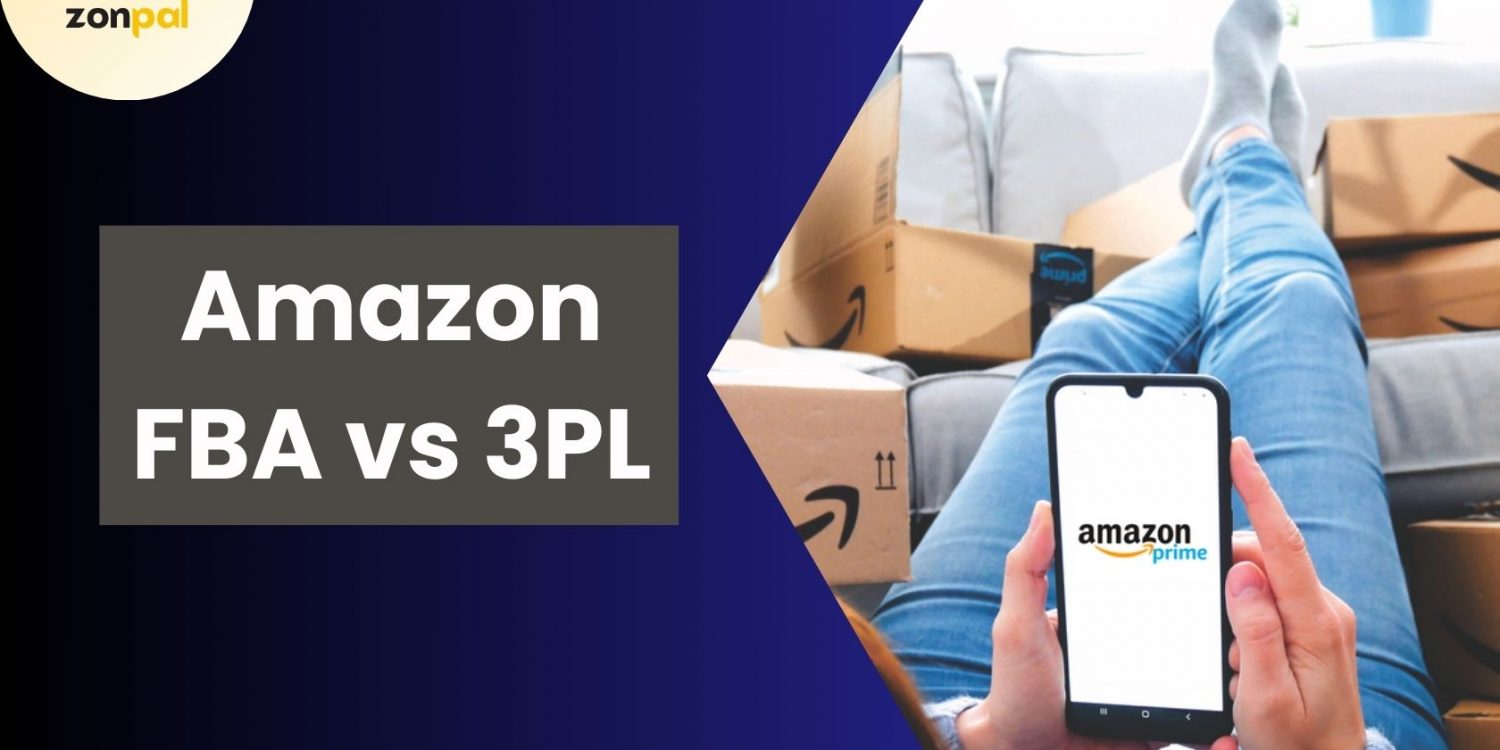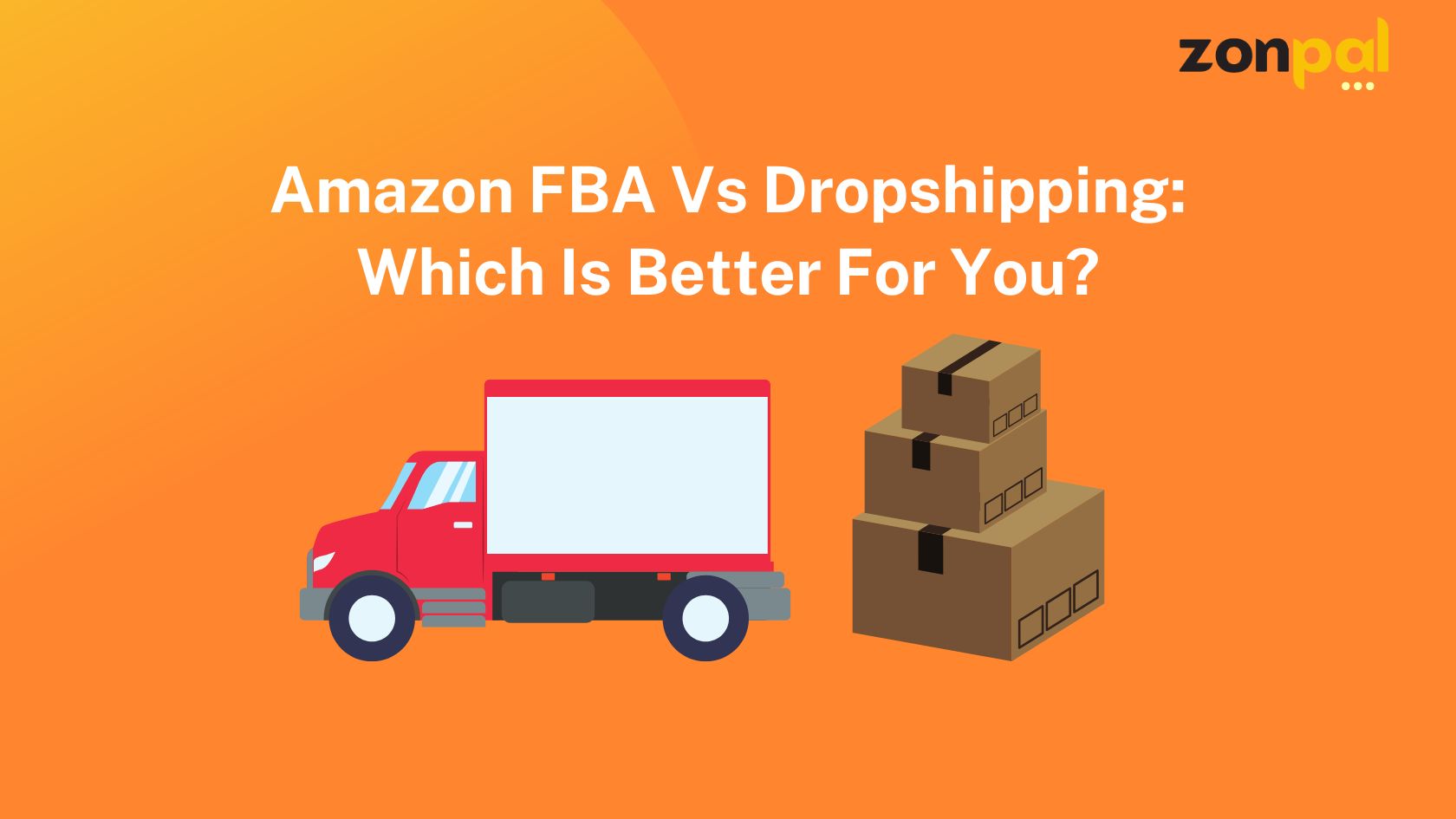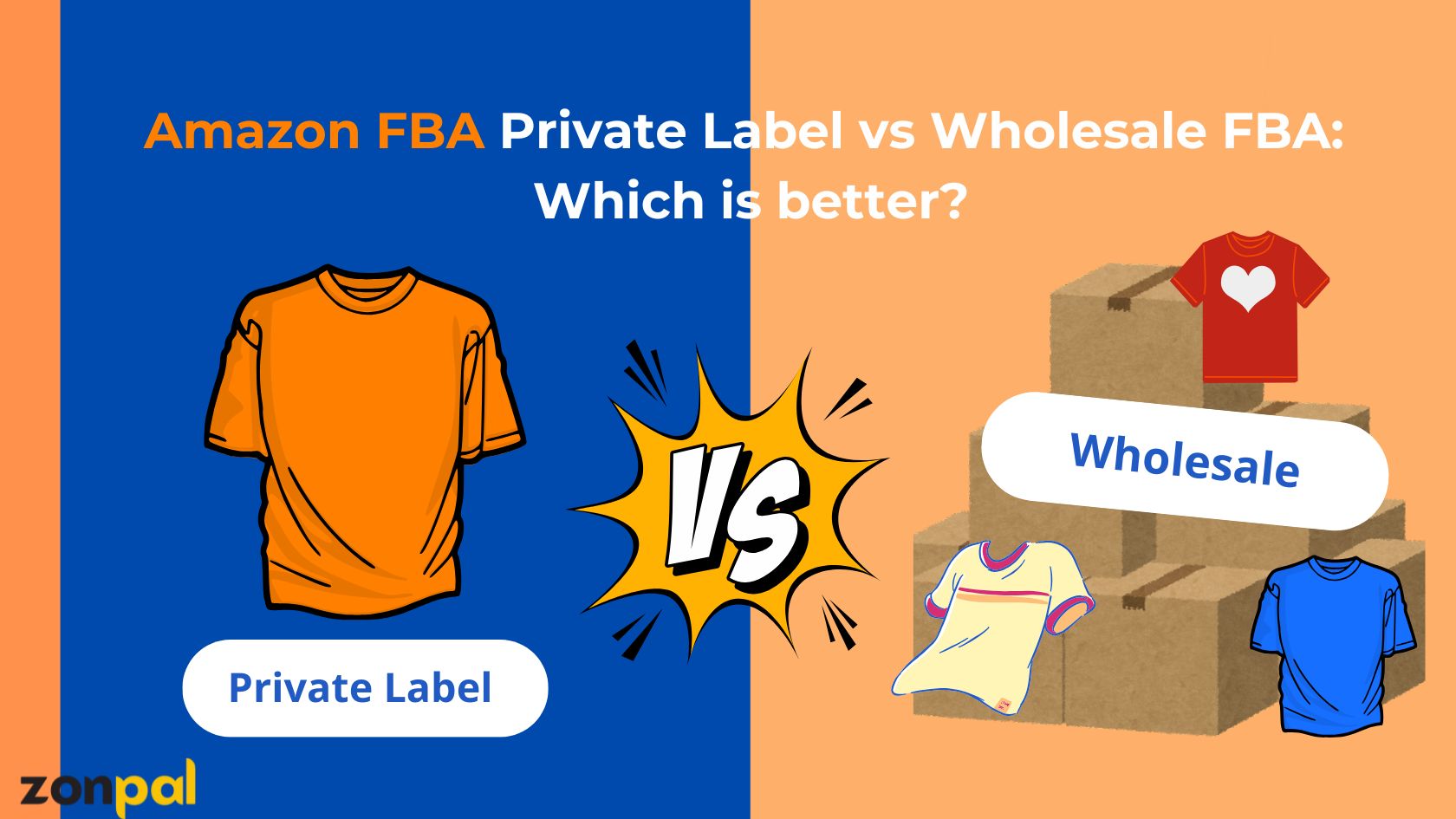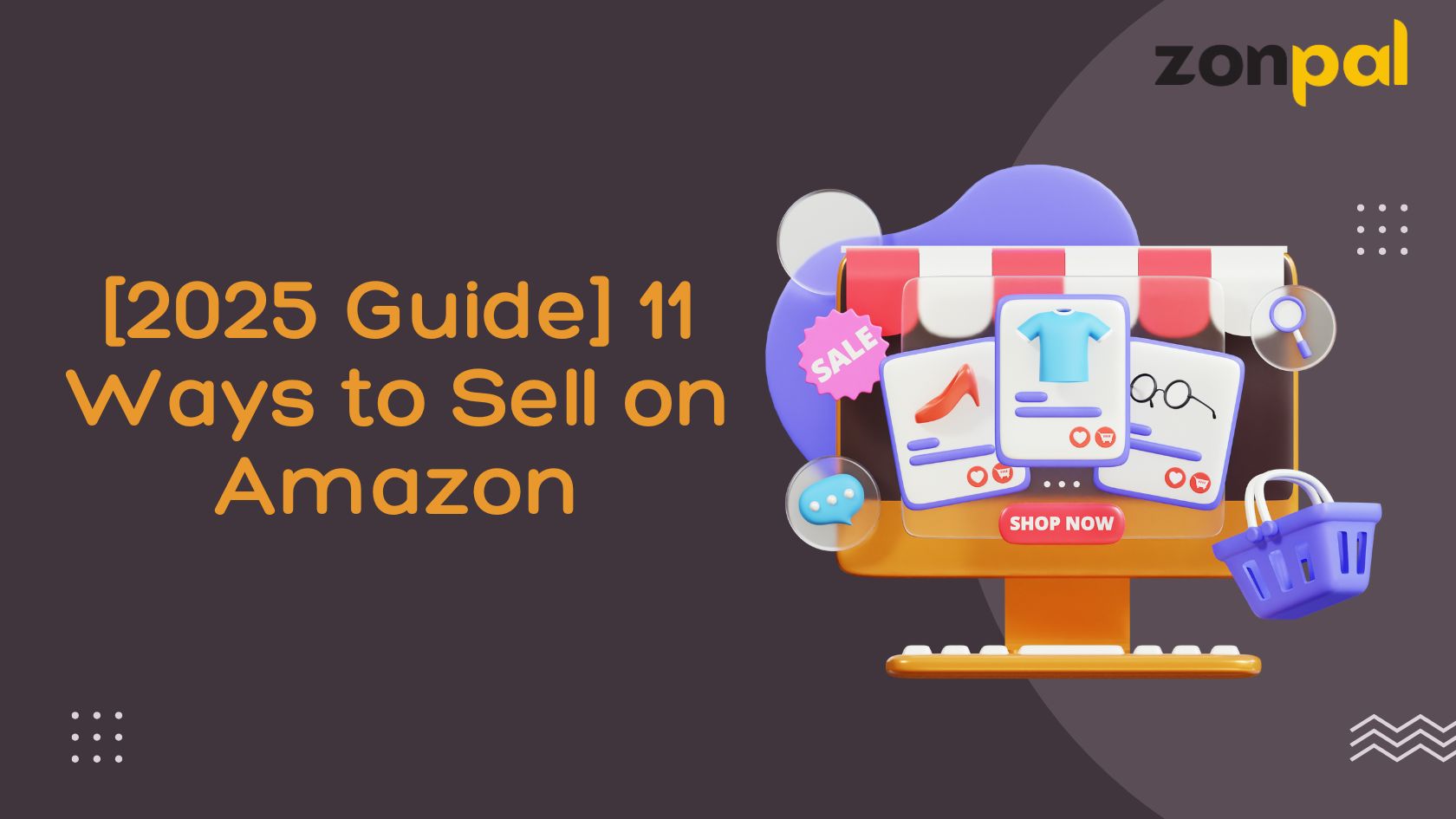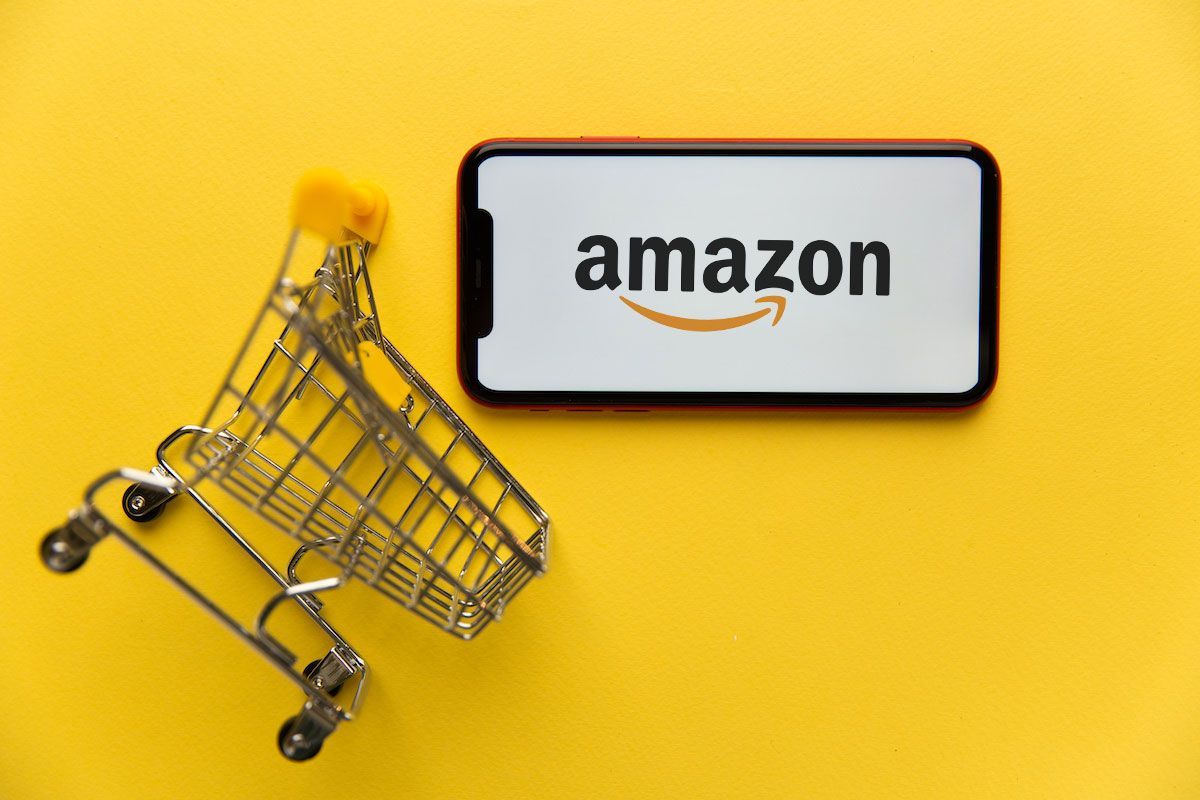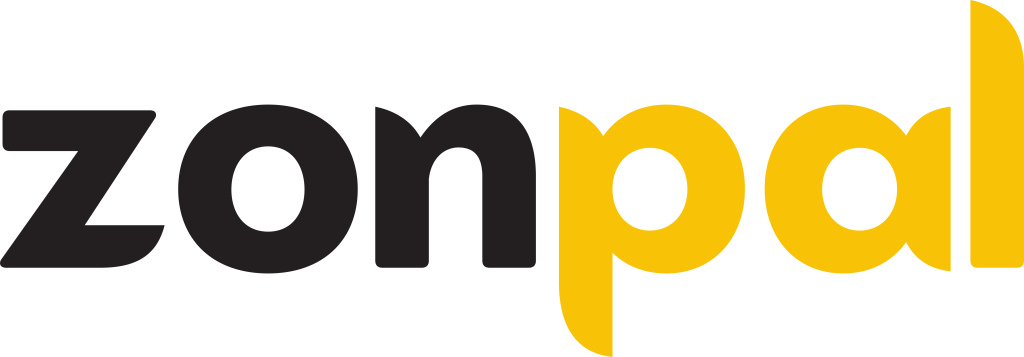Amazon FBA vs 3PLs: Pros, Cons, and Which to Choose in 2025
Fulfillment is the heart of e-commerce success, especially for Amazon sellers. It’s no easy task inventory issues, shipping delays, and customer service demands can trip you up. That’s why many sellers outsource to Amazon FBA (Fulfillment by Amazon) or 3PLs (Third-Party Logistics). We know the right fulfillment choice can mean faster deliveries, easy returns, and loyal customers.
Deciding between FBA and 3PLs is a big deal. FBA offers Amazon’s logistics and Prime perks, while 3PLs give flexibility for multi-channel sales. Choose wrong, and you risk higher costs or unhappy customers. Not sure which is best for your business? We’re breaking down the Amazon FBA vs 3PLs debate with clear insights to help you pick the perfect strategy for 2025.
What’s Amazon FBA vs 3PLs
Before diving into the nitty-gritty, let’s clarify what Amazon FBA and 3PLs actually are.
- Amazon FBA: Fulfillment by Amazon is a service where sellers store their products in Amazon’s fulfillment centers. Amazon handles storage, packing, shipping, customer service, and returns for orders placed on Amazon’s marketplace. Sellers benefit from Amazon’s logistics prowess and Prime eligibility, but they must adhere to strict guidelines and pay associated fees.
- 3PLs: Third-party logistics providers are external companies that manage warehousing, inventory, and shipping for businesses. Unlike FBA, 3PLs are not tied to a specific marketplace, offering flexibility to fulfill orders across multiple sales channels (e.g., Shopify, Walmart, or your own website). Services vary by provider, ranging from basic warehousing to advanced analytics and customized packaging.
What is the Difference Between Amazon FBA vs 3PLs?
To make an informed decision, you need a clear picture of how FBA and 3PLs stack up. Below, we outline the advantages and challenges of each, drawing from our experience and industry data.
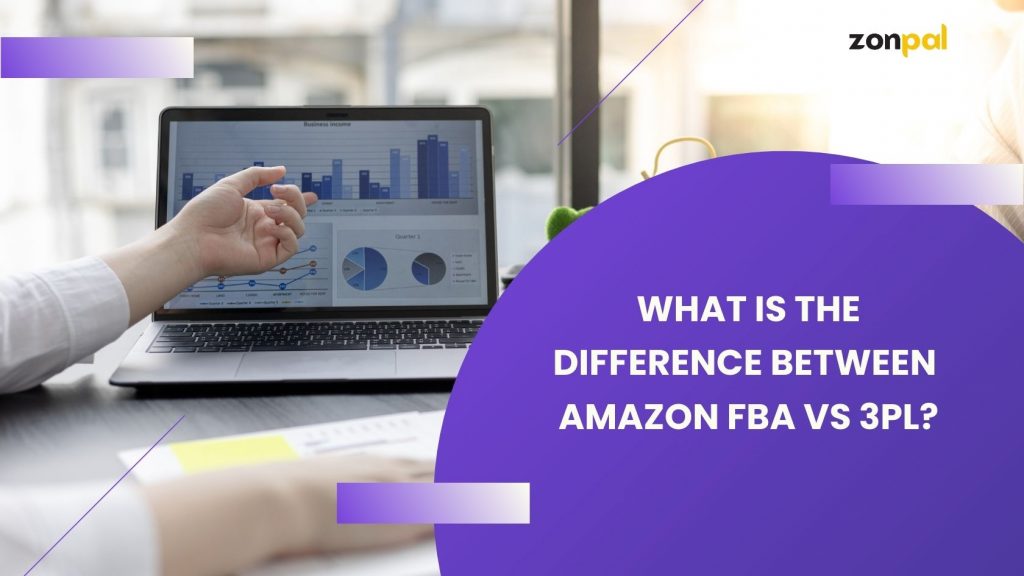
What is the difference between Amazon FBA vs 3PLs?
Pros of Amazon FBA
- Prime Eligibility:
FBA products automatically qualify for Amazon Prime, which drives sales. A 2024 Statista report shows that about 75% of Amazon shoppers in the U.S. were Prime members. This widespread adoption means that FBA sellers, whose products are Prime-eligible by default, enjoy a clear competitive advantage.
- Scalable Logistics:
Amazon’s global network of fulfillment centers handles millions of orders daily. This scalability is helpful for sellers with high sales. It also benefits those who expect busy times.
- Customer Trust:
Amazon’s A-to-Z Guarantee and seamless returns process enhance buyer confidence, reducing cart abandonment.
- Hands-Off Operations:
FBA manages everything from picking to shipping, freeing sellers to focus on product development and marketing.
💡Zonpal’s Take: For small to medium-sized sellers, FBA’s plug-and-play model is a game-changer. Sellers will double their conversion rates simply by leveraging Prime badges.
Cons of Amazon FBA
- High fees
High fees can significantly reduce your profits when using Amazon FBA. If your products sit in their warehouses too long, Amazon charges for storage, fulfillment (picking, packing, and shipping), and long-term storage. For example, if you sell a $10 item or a large product like a yoga mat, the fees might leave you with very little profit. Make sure you use tools like Amazon’s FBA Calculator to estimate fees before starting.
- Limited control
Amazon has strict rules about how products must be prepped, labelled, and shipped to their warehouses. These requirements can be time-consuming and expensive, especially if you make mistakes and need to fix them. For instance, if your labels are incorrect, Amazon might reject your shipment or charge extra fees. This lack of flexibility can feel frustrating, particularly for small businesses with unique products. It’s better than setting up a clear prep checklist to avoid costly errors.
- Inventory risks
If you send too much stock to Amazon’s warehouses, you could face long-term storage fees, which increase after six months. On the other hand, sending too little inventory risks running out of stock, which can lead to lost sales and lower rankings on Amazon. Balancing this is tricky, especially during busy seasons like the holidays.
- Amazon dependency
When you rely on FBA, your business is tied to Amazon’s rules, fees, and algorithm changes, which can shift without warning. For example, a sudden policy update or fee increase could disrupt your operations or margins. This lack of control makes it risky to depend solely on Amazon for your sales.
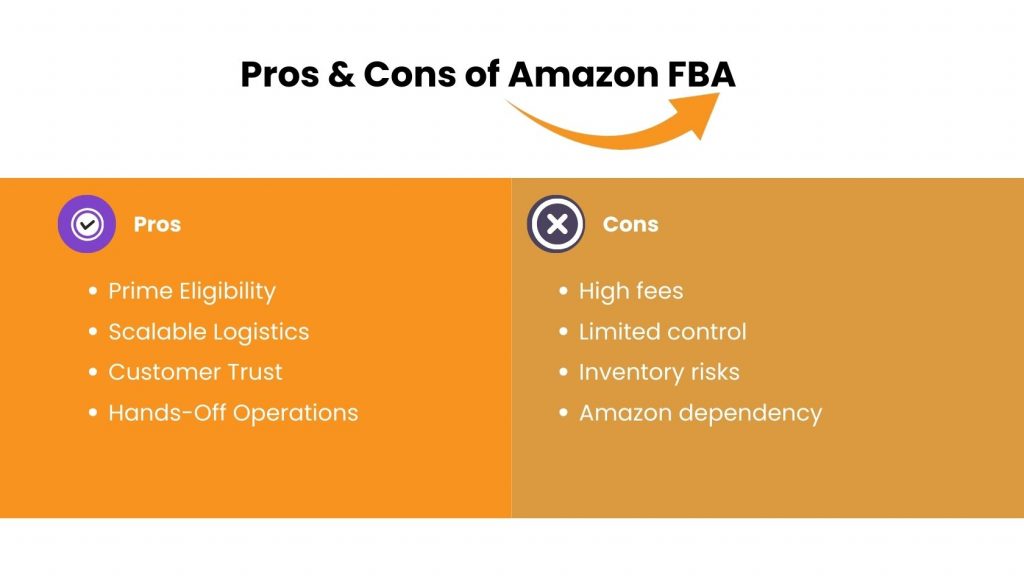
Pros & cons of Amazon FBA
Pros of 3PLs
- Multi-Channel Flexibility:
3PLs for FBA sellers help with easy order fulfilment on different platforms. This makes them a smart choice for sellers on Shopify, eBay, or their own websites. This flexibility supports business growth and ensures consistent customer experience across sales channels.
- Customization:
3PLs offer tailored solutions, such as branded packaging or kitting, which enhance customer experience. For example, one of our clients in the beauty industry used 3PLs and included personalized thank-you notes, which boosted repeat purchases by 20%.
- Cost Control:
3PLs pricing is often more predictable, with customizable plans based on your needs. This contrasts with FBA’s complex fee structure.
- Inventory Control:
3PLs typically offer greater visibility into stock levels and fewer restrictions on product types, such as hazardous goods.
💡Zonpal’s Take: 3PLs shine for brands with diverse sales channels or unique packaging needs. We recommend this fulfillment approach for sellers who want to build a distinct brand identity outside Amazon’s ecosystem.
Cons of 3PLs
- No Prime badge
No Prime badge is a significant drawback for 3PL users selling on Amazon. Orders fulfilled by third-party logistics providers don’t qualify for Amazon Prime, which means your products won’t have the Prime logo that attracts many shoppers. For sellers who rely heavily on Amazon, this is a big disadvantage.
- Integration complexity
To use a 3PL, you need to connect their system with your sales platforms, like Shopify, Amazon, or your own website. This requires technical setup and software, which can be confusing for beginners. We suggest choosing a 3PL with user-friendly software and strong customer support to simplify this process.
- Variable service quality
Not every 3PL provider delivers the same level of service. Some may have slow shipping, poor communication, or frequent mistakes, like sending the wrong product. These issues can harm your brand’s reputation and lead to negative customer reviews. Unlike FBA, where Amazon’s service is consistent, 3PL quality varies widely.
- Higher upfront costs
Some 3PLs charge setup fees, require minimum order volumes, or have higher initial costs for things like custom packaging. This can be tough for small businesses or startups with limited cash flow. For example, a 3PL might ask for a $500 setup fee or a minimum of 100 orders per month, which could be challenging early on.
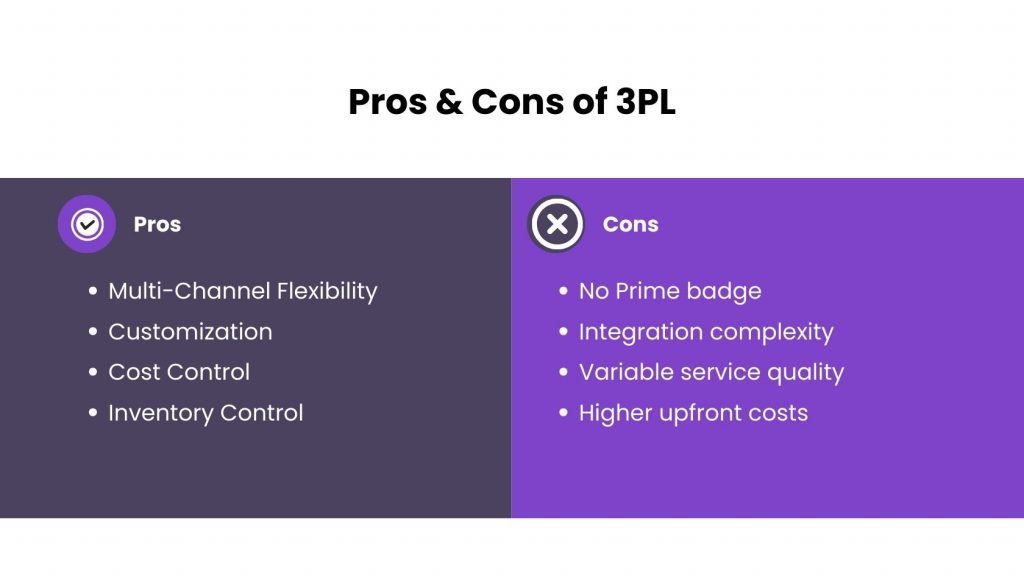
Pros & cons of 3PL
>>> Read more: Amazon FBA Vs Shopify: Which Model Should You Choose? <<<
Key Factors to Choose Between Amazon FBA and 3PL
Choosing between Amazon FBA and 3PLs can be tough. It really depends on knowing your business and what drives it. To make this decision easier, let’s walk through four key factors to help you choose confidently.
- Product Type: What Are You Selling?
The type of products you sell greatly affects whether an FBA or a 3PL is the better fit. Think about your items’ size, weight, and nature, as they affect storage and shipping costs.
Amazon FBA works best for small, lightweight, and fast-selling products. Amazon’s fulfillment centers are made for items that fit well on shelves and ship fast. This includes books, phone accessories, and small gadgets. For example, if you sell $15 phone cases, FBA’s fees are manageable, and your products can move fast with Prime eligibility. However, if your products are bulky, like furniture or yoga mats, FBA’s storage and fulfillment fees can eat into your profits.
3PLs are ideal for large, heavy, or specialized products that don’t play well with FBA’s fee structure. For example, if you sell large camping gear or products that need special care, a 3PL can help. They provide custom solutions at lower costs. Plus, 3PLs are more flexible with products Amazon might restrict, such as hazardous goods.
💡Zonpal’s Tip: List out your products and check their dimensions and weight. Use Amazon’s FBA Calculator to estimate fees, then compare with 3PLs quotes. If your items are big or specialized, a 3PL might save you money and hassle.
- Sales Channels: Where Are You Selling?
Your sales channels, where your customers buy your products greatly influence whether FBA or a 3PL makes sense. Are you fully committed to Amazon, or do you sell on other platforms too?
Amazon FBA is a no-brainer if Amazon is your main (or only) sales channel. FBA works closely with Amazon’s marketplace. It provides fast shipping and the Prime badge. This can lead to more clicks and sales. If most of your revenue comes from Amazon, FBA’s streamlined process lets you focus on marketing and product development.
3PLs shine for businesses selling on multiple platforms, like Shopify, Walmart, eBay, or your own website. A 3PL can fulfill orders from all these channels from one warehouse, keeping things organized and efficient. This flexibility is crucial if you want to build a brand beyond Amazon. For instance, if you run a Shopify store and also sell on Amazon, a 3PL can handle both while letting you customize the customer experience, like adding branded inserts.
💡Zonpal’s Tip: Outline your sales channels and their revenue distribution. If Amazon is your primary sales driver, using FBA keeps things straightforward. If you sell on different platforms or want to grow beyond Amazon, a 3PL gives you the flexibility to expand.
- Budget and Costs: What Can You Afford?
Amazon FBA has higher per-unit fees but requires less upfront investment. You pay for storage, fulfillment, and sometimes long-term storage fees, which can add, especially for slow-moving or bulky items. FBA does not require you to buy your own warehouse or software. This makes it easier for new sellers with little money. It’s like renting Amazon’s logistics machine.
3PLs can be more cost-effective for certain businesses, especially if you sell high-margin products that generate strong profits to offset initial costs. While 3PLs may charge setup fees or require software integration, their per-unit costs are often lower than FBA’s, particularly for large items. You also gain flexibility to negotiate pricing and avoid FBA’s steep storage fees. We recommend getting quotes from multiple 3PLs to find a cost structure that maximizes your profits.
💡Zonpal’s Tip: Analyze the price. Use Amazon’s FBA Calculator and get quotes from at least two 3PLs. Factor in not just fees but also your time and resources. If you’re experiencing cash flow constraints, FBA’s minimal initial expenses could be the ideal solution.
- Business Stage and Goals: Where Are You Headed?
Your business’s current stage and plans determine whether FBA or a 3PL aligns with your vision, whether you’re launching a startup or building a long-term brand.
Amazon FBA is fantastic for startups or small businesses looking to grow quickly on Amazon. It lets you tap into Amazon’s massive customer base and logistics network without building your own infrastructure. If your goal is to test products or scale fast on Amazon, FBA handles the heavy lifting so that you can focus on sourcing or marketing.
3PLs suit established businesses or those aiming for brand control and multi-channel growth. If you plan to sell on your own website or other marketplaces, a 3PL can help. It allows you to create a unique customer experience and avoid Amazon’s rules. It’s also great for businesses with steady sales that want to optimize costs and operations.
Zonpal’s Tip: Ask yourself: Are you testing the waters or building a brand? If you’re new or Amazon-focused, FBA is a low-risk starting point. If you’re established and want to own your customer experience, a 3PL supports your bigger goals.
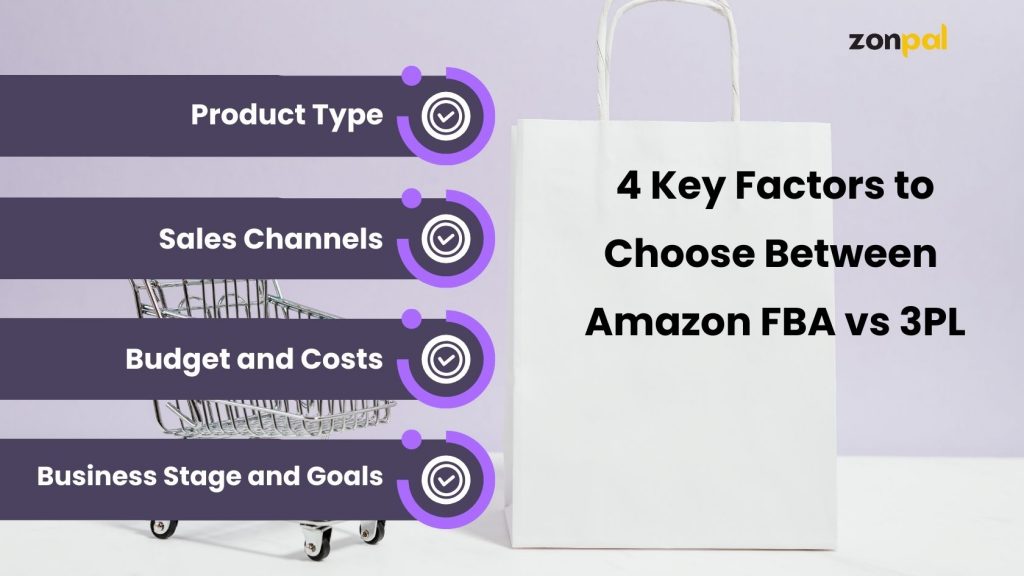
4 key factors to choose between Amazon FBA and 3PLs
Emerging Trends: The Hybrid Approach
In 2025, the hybrid fulfillment approach is a rising trend, blending Amazon FBA and 3PLs to maximize efficiency. At Zonpal, we see this strategy helping sellers save costs and reach more customers.
With a hybrid model, you use FBA for Amazon orders to leverage the Prime badge. For other channels like Shopify or your website, a 3PL handles fulfillment, offering custom packaging and lower fees.
This approach also helps manage inventory smarter. Store bulky items or excess stock with a 3PL to avoid FBA’s steep storage fees, then ship to Amazon as needed. It’s perfect for holiday rushes or oversized products.
💡Zonpal’s Tip: Begin with a hybrid model by using FBA for Amazon and a 3PL for other platforms. Use inventory software to stay organized. This approach offers flexibility and ensures customer satisfaction across all channels.
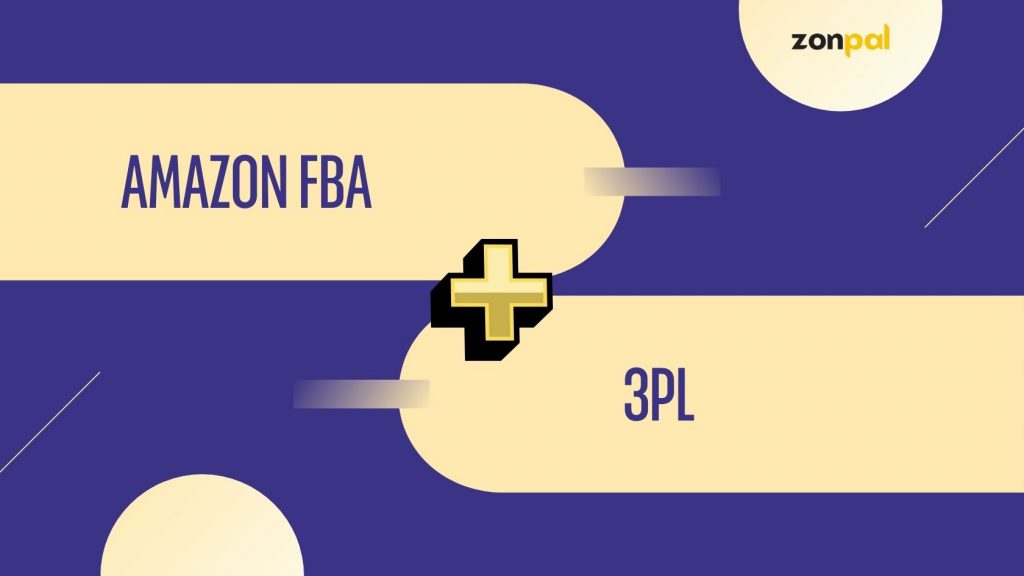
Hybrid fulfillment Amazon FBA vs 3PLs
FAQs
What are the key distinctions between Amazon FBA and 3PLs?
FBA is Amazon’s own fulfillment service. The design targets Amazon’s marketplace and offers Prime eligibility with easy logistics. 3PLs are independent providers offering multi-channel fulfillment, greater customization, and flexibility but lack Prime benefits.
Is Amazon FBA or a3PL more cost-effective for my business?
It hinges on your products, sales platforms, and order volume. FBA suits Amazon-centric sellers with small, fast-selling items. 3PLs are typically more affordable for multi-channel sellers or those with large items. Compare costs using Amazon’s FBA Calculator or 3PLs quoting tools, and factor in your profit margins to choose the most cost-effective option.
Can I use 3PLs and still get Amazon Prime benefits?
Yes, through Amazon Seller-Fulfilled Prime (SFP), if you meet strict requirements like 99% on-time delivery. Otherwise, only FBA orders qualify for Prime. Alternatively, use a hybrid model with FBA for Amazon orders and 3PLs for other platforms to balance Prime benefits and flexibility.
How do FBA and 3PLs compare in managing inventory?
FBA’s system is simple for Amazon but gives less visibility and control. 3PLs offer better tools, like real-time tracking and forecasting, though quality depends on the provider.
What should I look for when choosing a 3PL provider?
Prioritize 3PLs with reliable shipping, user-friendly software for platform integration, and transparent pricing. We suggest testing a small batch and checking reviews to ensure consistent service quality.
Conclusion
Deciding between Amazon FBA and 3PLs is a pivotal choice that shapes your e-commerce success. FBA excels for Amazon-centric businesses seeking speed and simplicity, while 3PLs offer unmatched flexibility for multi-channel growth. The emerging hybrid approach further bridges the gap, allowing savvy sellers to leverage the best of both worlds.
Our advice? Start by assessing your product type, sales channels, budget, and long-term vision. Test small, track metrics, and don’t hesitate to pivot as your business evolves. With the right strategy, you’ll not only meet customer expectations but also build a scalable, profitable operation.
For personalized guidance, reach out to our Consulting & Strategies experts, we’re here to help you navigate the complexities of e-commerce fulfillment with confidence.

